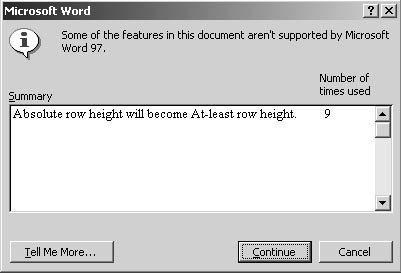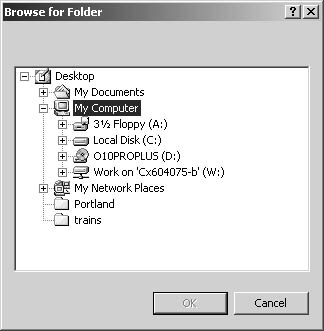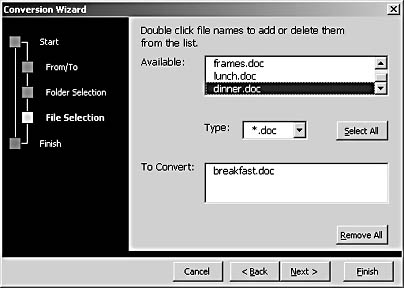Sharing Files and Folders
3 4
Part of the beauty of working on a network is that you can easily share files, folders, networked locations, and hardware resources (such as computers, Zip drives, printers, scanners, and so forth) with anyone linked to your network. In addition, you can frequently access networks from various locations. This capability can come in quite handy and can save you time because you won't have to continually copy information to a disk if you want to use the information on another computer and you won't be stranded in one location while your files sit in another. Because Word is a document creation program and sharing files and folders represents one of the most prominent reasons for networking, we'll look at sharing those resources in more depth here.
Sharing Word Information On Line
You can share information with other Word users in a number of ways. To share your information effectively, you should design your resource-sharing setup based on who will be accessing the information and how the information should appear. You can share files or folders using any of the following techniques:
- Post the information to a public folder on Microsoft Exchange Server. For example, you can open a file and choose File, Send To, Exchange Folder if your network has the Exchange Server extensions installed.
- Save the information on a SharePoint team Web site. SharePoint team Web sites are discussed in more detail in the section "Sharing Information on Team Web Sites."
- Save the information in a shared network or Internet folder. To learn more about Internet folders and network locations, see Chapter 29, "Keeping an Eye on Word's Online Features."
- Send a copy of a file to others using Word e-mail, fax, or NetMeeting features. For more information about sending documents while working in Word, see Chapter 30, "Collaborating On Line with E-Mail, NetMeeting, Discussions, and Faxes."
- Share a folder with others on your intranet using Windows 2000 sharing. For more information about sharing resources in Windows 2000, see the sidebar "Using Windows 2000 to Share Folders on Your Intranet" as well as Appendix D, "Quick Guide to Peer-to-Peer Networks."
- Store the information on a discussion server. For more information about Web Discussions and discussion servers, see Chapter 30, "Collaborating On Line with E-Mail, NetMeeting, Discussions, and Faxes," as well as the section "Sharing Information on Team Web Sites."
Choosing how you want to share resources can be fairly straightforward. For example, if you're sharing a few computers on a peer-to-peer network made up of trusted resources, you'll probably feel comfortable simply specifying files and folders as shared resources in Windows 2000. On the other hand, if you know you have resources that people will need to access from many parts of the world, you'll be better served by sharing documents in an Internet folder. To take advantage of other sharing options, such as public folders and SharePoint team Web sites, you'll need to determine whether your server has Exchange Server extensions, Office Server extensions, or SharePoint Team Services installed.
For information about setting up a peer-to-peer network, see Appendix D, "Quick Guide to Peer-to-Peer Networks."
Using Microsoft Windows 2000 to Share Folders on Your Intranet
Windows 2000 makes it easy to share folders on intranets. The minor catch is that before you can share a folder with others on your intranet in Windows 2000, you must be logged on as a member of the Administrators group or as another type of user with sufficient privileges. After you've verified your logon status, follow these steps to share a resource:
- In Windows Explorer, right-click the folder you want to share, and choose Sharing on the shortcut menu.
- On the Sharing tab in the folder's Properties dialog box, click Share This Folder.
- If desired, click the Permissions button on the Share tab to access the Permissions dialog box for the folder, and then specify permission settings, such as Full Control, Change, and Read for selected groups. Click OK to close the dialog box.
- Click OK to close the Properties dialog box.
After you share a folder, the folder icon changes to a hand holding a folder. This lets you quickly determine which folders are shared on your computer. Others on your network can now navigate to your computer and view the contents of the folders you've shared.
Sharing Documents with People Using Other Versions of Word
As you know, the software world changes much more quickly than many offices and people tend to update their systems. In addition, people use a variety of hardware platforms and operating systems. Therefore, you'll find that you occasionally want to share Word documents with people who are using earlier versions of Word or using Macintosh versions of Word. Conveniently, Word includes several features that assist you when you want to share documents with people using other versions of Word (or people who aren't using Word at all).
Note
You can use Word 2002 to open documents created in Word 2000, Word 97, Word 95, Word 6.0, or Word 2.0. All data and formatting in documents using those versions of Word are fully supported in Word 2002.
Sharing Documents with Word 2000 and Word 97 Users
If you share documents with people who use Word 2000 or Word 97, you can save your documents in the standard Word document format. If desired, you can quickly create new documents or modify existing documents specifically for use in Word 97 by turning off features not supported in that version. To turn off features not supported in Word 97, follow these steps:
- Ensure that the document you want to save is open in Word.
- Choose Tools, Options, and click the Save tab. The Save tab in the Options dialog box is shown in Figure 32-1.

Figure 32-1. You can configure the settings on the Save tab to establish a default file format for new documents as well as disable features that aren't supported in earlier versions of Word.
- Select the Disable Features Introduced After check box, select the version of Word you want in the drop-down list, and click OK. If appropriate, Word will display a summary of features in the document that aren't supported in the selected version of Word, as shown in Figure 32-2. Click the Tell Me More button to access additional information about features that aren't supported in the selected version of Word. After you finish reviewing the information, close the Help window, and then click Continue.

Figure 32-2. Word displays a summary of features found in the current document that aren't supported in the newly selected document format.
After you turn off features not supported by earlier versions of Word and save the document, the document can be used in the specified version of Word. If you work with the document in Word 2002, you'll notice that some of the features are unavailable on menus. If you choose an unavailable option (such as choosing Insert, Hyperlink when you're working on a document for Word 6.0), a dialog box will appear, stating that the feature is currently disabled. The dialog box includes a Tell Me More button that you can click to access further information about the disabled feature.
Note
You can't use the Disable Features Introduced After option when you're saving Web pages—Word 97 and earlier versions don't support HTML documents.
Sharing Documents with Word for Windows 95 Users
In addition to saving documents for people who use Word 2000 and Word 97, you can prepare your documents so that they're accessible in Word 6.0 or Word 95 for Microsoft Windows 95. You can achieve this compatibility using one of the following techniques:
- Save existing documents in Word 6.0 or Word 95 format. To save your document as a Word 6.0 or Word 95 file, choose File, Save As, and then select Word 6.0/95 in the Save As Type drop-down list. When you save a document in Word 6.0 or Word 95 format, Word replaces formatting in your document that isn't supported in Word 6.0 and Word 95 with formatting that is supported in those versions. Word then displays a dialog box showing the formatting changes that will be made in your document. In addition, when you work in a document that you saved in Word 6.0 or Word 95 format, Word automatically makes features unavailable that are not supported in Word 6.0 and Word 95. This makes it easy for you to create documents in Word 2002 that will not lose data or look different when viewed in Word 6.0 or Word 95.
- Turn off unsupported features while you work. To turn off unsupported features while you work, choose Tools, Options, click the Save tab, and configure the Disable Features Introduced After setting. (For more detailed information, see the section "Sharing Documents with Word 2000 and Word 97 Users.") When you turn off unsupported features, you can create new documents or modify existing documents specifically for use in Word 6.0 or Word 95.
- Send users a Word converter or viewer application. Microsoft includes converters and viewers with Word, and they are also available for download from the Microsoft Office Update Web site Word downloads page. You can send a converter or a viewer application to users of Word 6.0, Word 95, or Microsoft Works, for Microsoft Windows, Microsoft Windows NT, or Apple Macintosh operating systems. Others can download a converter or viewer from the Microsoft Office Update Web site at http://office.microsoft.com. To download a converter or viewer from the Office Update Web site, display the Web page, click Word, click Download, choose Converters And Viewers on the downloads page, click Search Now, and then download the converter or viewer you need. After users install a converter or viewer, they can directly open Word 2002 documents.
Receiving Notification When a Document Is Converted
If you want to know which converter (if any) is being used when you open a document, you can display the Convert File dialog box, shown here:

To configure Word to notify you when files are converted, follow these steps:
- Choose Tools, Options, and click the General tab.
- Select the Confirm Conversion At Open check box, and click OK.
After you set this option, the Convert File dialog box will be displayed when you open a file that must be converted. When you see the Convert File dialog box, simply click OK to open the document normally. (The file's default file format will be selected by default.) If you click Cancel, the process will be aborted, and the document won't be opened. If you select another file format in the Convert File dialog box, the document will be opened in the selected format. For example, if you select Plain Text in the Convert File dialog box when you're opening a Web page document, you'll see a text document that shows the HTML source code for the Web page instead of the standard WYSIWYG view Word normally displays when you open HTML documents.
Converting a Batch of Files to or from Word Format
In some cases, you might want to convert a number of Word files to another format. For example, you might want to convert a collection of files for a client who uses WordPerfect. You can easily convert a batch of files by using the Conversion Wizard included with Word. To do so, follow these steps:
- Choose File, New to open the New Document task pane.
- In the New Document task pane, click the General Templates link, and then choose the Other Documents tab.
- Double-click the Batch Conversion Wizard icon. The Start page is shown in Figure 32-3.

Figure 32-3. The Conversion Wizard walks you through the process of converting a number of files at one time.
- Click Next, and then specify whether you want to convert documents to Word format or convert Word documents to another format by selecting the appropriate option and choosing the file type in the drop-down list.
- Click Next, and on the Folder Selection page, click the Source Folder Browse button. The Browse For Folder dialog box opens, as shown in Figure 32-4. Select the appropriate folder, and click OK.

Figure 32-4. You can use the Browse For Folder dialog box to specify the folder that contains the files you want to convert and where you want to store the converted files.
- Click the Destination Folder Browse button, select the folder in which you want to store the converted files, and click OK.
- Click Next to display the File Selection page, shown in Figure 32-5, where you can specify the files you want to convert. To select a file, double-click the file name in the Available list; the file name will be displayed in the To Convert list. Continue to double-click file names in the Available list until all the files you want to convert appear in the To Convert list. If you want to convert all the files, click the Select All button. You can filter the Available list view by choosing a file type in the Type drop-down list.
- After you've added files to the To Convert list, you can remove a single file by double-clicking it or click Remove All if you decide not to convert the specified files. When you've completed the File Selection page, click Next, and then click Finish to complete the conversion. You'll see the Batch Conversion Progress dialog box, and then a final message box will appear, asking whether you want to perform another conversion. Click Yes to perform another conversion, or click No to close the dialog box.

Figure 32-5. The File Selection page enables you to pick and choose the files you want to convert.
Keep in mind that when you perform a batch conversion, you don't delete or change the original files. Instead, you create copies of existing files that are stored in another file format.
Setting a Default File Format
If you frequently save documents in a particular format other than as standard Word 2002 documents (for example, perhaps you need to share most of the documents you create with a client who uses Word for Macintosh or WordPerfect), you can change the default file format Word uses to save new documents. To do so, follow these steps:
- Choose Tools, Options, and click the Save tab.
- In the Default Format section, click the Save Word Files As down arrow, and choose the file format you want to use as your default file format in the drop-down list.
- Click OK.
Remember that when you configure the default file format, the setting affects only new documents you create. Word saves existing documents in the same format in which they were opened.
EAN: 2147483647
Pages: 337
- Structures, Processes and Relational Mechanisms for IT Governance
- Linking the IT Balanced Scorecard to the Business Objectives at a Major Canadian Financial Group
- A View on Knowledge Management: Utilizing a Balanced Scorecard Methodology for Analyzing Knowledge Metrics
- Technical Issues Related to IT Governance Tactics: Product Metrics, Measurements and Process Control
- Managing IT Functions